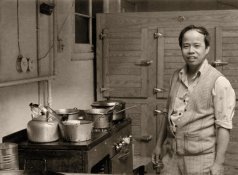Hi Ian,
I generally use soap flakes that are intended for washing clothes; the ones I get seem to be pretty much pure soap. I do make my own soap too; for printing the best results were from soap made with very little (if any) excess fats, which is not ideal for washing hands with! Castille soap should work well though if the pigments are 'soap friendly'. I am not sure exactly what chemical processes are important in the glop making, but I suspect it could be the shapes of the particles or more likely that it is the oils or tars in the soot that react with the soap to create some rather nice properties. A soap based formula with ground charcoal is hideous and foams like crazy with endless bubbles (which is what also happens with watercolour paint and soap glop); the shapes of the ground particles are very different, but also there is no oil as there is with soot.
With the soot and soap recipe, I am pouring bubble free 'liquid silk' to make tissues within 1/2 hour of starting to soak my gelatine (20min soak, 10min to add pigment and filter). Without the soap, I use isoprop. alcohol to aid bubble dispersal and let it sit for some time (usually and hour or two) to de-gas. With the soap free glop I tend to get oily streaks on the surface and the soot particles tend to clump more and I get rougher and more uneven tissue. I have made tissues using ground coffee and the behaviour was very similar to the soap/non-soap recipes as I see with soot, again leading me to suspect it is an interaction of the soap and the oils. I think that if you have a risk of oil contamination of the pigment, a soap glop is worth a try; if it works, it is great, but if it does not, it is a disaster, so try a small 100ml batch test. I also found that using detergents rather than soap caused foaming and bubble issues that I do not see with real soap, however the pigment dispersion was much improved over the isoprop. glop.
My typical recipe is: 750ml water, 100g food-grade gelatine, 80g sugar, 10g soap, 30g soot. I pour 50ml of glop for an 8"x10" area. I tend to go for higher contrast tissues (low relief) as I print onto sized watercolour paper and struggle to get relief even with thick tissues. The higher-contrast thinner tissues also mean my negatives do not have to be so dense (I still end up with a 1% dichromate solution often though). If I am not using soap, I replace the soap with about the same weight of isoprop. alcohol.
Best regards,
Evan








